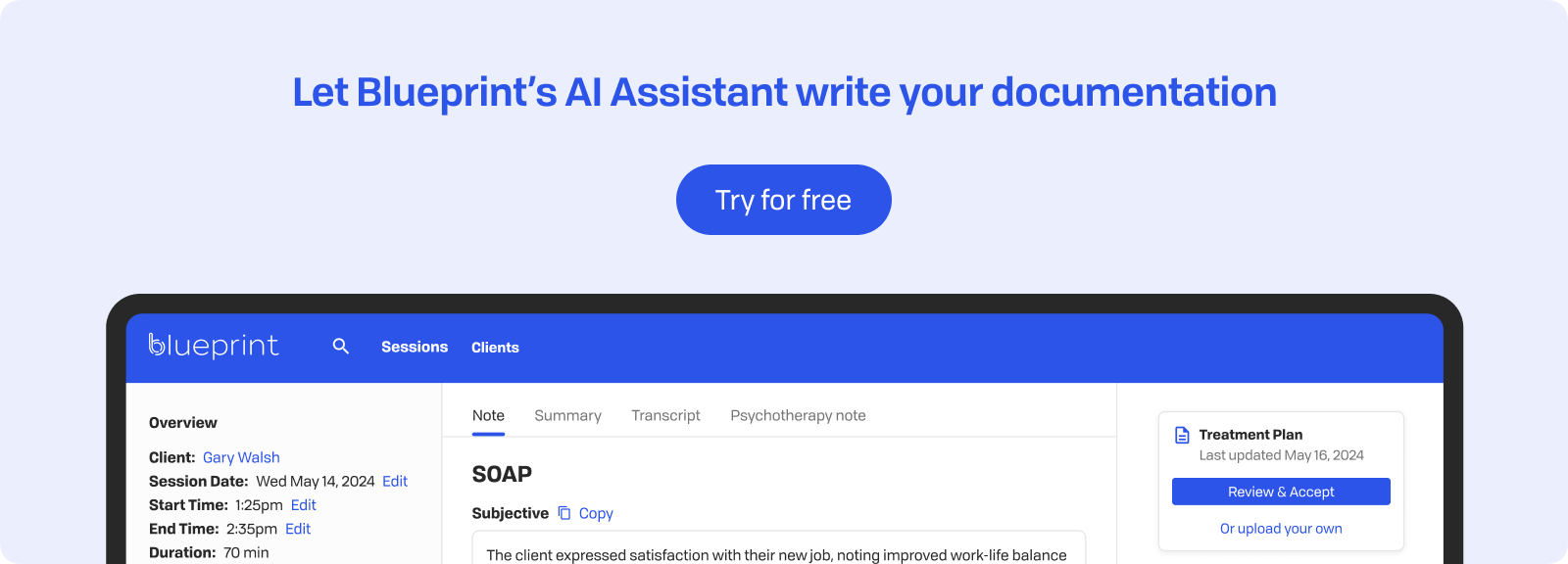
In Brief
Avoidance behavior appears in nearly every therapy room, often wearing different masks. Sometimes a client cancels sessions when topics feel too uncomfortable. Other times, someone subtly changes the subject whenever grief, anger, or vulnerability arise.
Recognizing these patterns is important for effective therapy. When we see avoidance as a protective strategy that's no longer helpful, we can guide clients toward healing. The challenge lies in distinguishing healthy boundaries from problematic avoidance.
This discussion explores the clinical aspects of avoidance behavior. We'll look at the different types therapists encounter, identify common triggers, examine the costs of chronic avoidance, and review proven interventions. Most importantly, we'll talk about supporting clients in safely facing what they've been avoiding.
Defining Avoidance Behavior in Clinical Terms
Avoidance behavior involves actions or inactions that prevent contact with uncomfortable thoughts, feelings, situations, or experiences. In clinical settings, we differentiate between adaptive avoidance—like stepping back from genuinely harmful situations—and maladaptive avoidance that disrupts functioning and well-being. The key difference is whether the avoidance protects or perpetuates distress.
Maladaptive avoidance maintains psychological symptoms through negative reinforcement. When someone with social anxiety skips parties, they feel immediate relief from anxiety. This relief reinforces the avoidance, making it more likely to happen again. Over time, avoided situations seem more threatening, and the person's world narrows.
The avoidance cycle has two timelines with opposing effects. Short-term, it offers immediate anxiety reduction, temporary relief, and a sense of control. Long-term, it increases anxiety sensitivity, leads to missed opportunities for corrective experiences, and reinforces catastrophic beliefs. What offers relief in the moment ultimately strengthens the very fears it aims to escape.
In anxiety disorders, avoidance prevents habituation and maintains threat perception. Someone with panic disorder who avoids exercise due to triggering sensations never learns these feelings are harmless. Depression-related avoidance often targets activities that could improve mood, creating a self-perpetuating cycle. Trauma-related avoidance extends beyond specific triggers to cover emotions, relationships, and experiences that might activate traumatic memories.

Types of Avoidance Therapists Encounter
Recognizing different forms of avoidance helps tailor interventions more effectively. While avoidance behaviors often overlap, noticing distinct patterns allows for more precise treatment planning.
- Cognitive Avoidance: This involves mental strategies to dodge distressing thoughts or memories. Clients might constantly distract themselves, overanalyze situations to avoid feelings, or engage in "toxic positivity" that dismisses genuine concerns. Some dissociate when topics become overwhelming, while others intellectualize to keep emotions at arm's length.
- Behavioral Avoidance: The most visible form includes skipping appointments, arriving late, or canceling when difficult topics are scheduled. Clients might avoid specific places, activities, or tasks that trigger discomfort. This extends to procrastination on homework assignments or refusing exposure exercises.
- Emotional Avoidance: Clients numb feelings through various means—substance use, excessive sleeping, or compulsive behaviors. They might describe emotions vaguely ("I feel bad") or default to one acceptable emotion (showing anger instead of vulnerability). Some clients stay perpetually busy to avoid quiet moments when feelings might surface.
- Interpersonal Avoidance: This manifests as withdrawing from relationships, avoiding conflict, or maintaining superficial connections. Clients might ghost friends who get too close, avoid dating, or create distance in therapy through humor or changing subjects. They may fear both rejection and intimacy equally.
Each type serves the same purpose: protecting against perceived emotional danger. Recognizing which forms dominate helps us understand what the client fears most and guides our intervention approach.
Recognizing Triggers in the Therapy Room
Avoidance behavior often becomes apparent through patterns in how clients share their stories. Look for sudden topic changes, vague language around sensitive areas, or consistent gaps in narratives. A client might provide detailed accounts of work stress but become notably brief when discussing family relationships. These narrative shifts may indicate avoidance triggers.
Physical and emotional cues offer real-time signs of avoidance activation:
- Physiological signs: Shifting posture, breaking eye contact, sudden fidgeting, changes in breathing patterns, or touching the face/neck
- Emotional markers: Abrupt mood shifts, nervous laughter, sudden fatigue, or expressions of confusion when topics were previously clear
- Verbal indicators: Increased "I don't know" responses, deflecting with humor, intellectualizing, or suddenly needing bathroom breaks
Subtle avoidance often disguises itself as cooperation. A client might arrive consistently but fill sessions with surface-level updates, appearing engaged while avoiding deeper work. They might complete homework selectively, addressing only comfortable aspects while "forgetting" challenging components.
Overt avoidance is more noticeable but equally important to address. This includes canceling sessions after difficult topics arise, arriving significantly late, or directly stating "I can't talk about that." Some clients explicitly request to avoid certain subjects or become visibly distressed when specific themes emerge.
The SIFT method (Sensations, Images, Feelings, Thoughts) helps clients slow down and recognize their triggered state. Teaching clients to notice these elements increases awareness of avoidance patterns, making triggers more manageable over time.

Therapeutic Costs of Avoidance
Unchecked avoidance behavior in therapy creates significant barriers to healing. The impact goes beyond stalled progress and can fundamentally undermine the therapeutic process and relationship.
Trauma processing and exposure work suffer most from avoidance patterns. Clients who consistently dodge traumatic memories or feared situations cannot engage in the experiences necessary for healing. Research shows that higher pretreatment avoidance predicts worse outcomes in exposure-based therapies, partly because clients complete less homework and skip important practice opportunities. Without facing feared stimuli, the brain cannot learn new safety associations, leaving anxiety and trauma responses intact.
The therapeutic relationship also bears the weight of chronic avoidance. When clients repeatedly disengage—through cancellations, surface-level discussions, or emotional withdrawal—it strains the working alliance. It's also important for therapists to recognize their own countertransference—feelings of frustration, being 'stuck,' or wanting to 'give up' on a client—as these can be signals that avoidance is at play. Recognizing these internal reactions allows us to address the pattern without reinforcing it. You might notice:
- Frustration building: Both you and your client may feel stuck, leading to mutual disappointment
- Trust erosion: Clients may feel you're pushing too hard; you may feel they're not committed
- Missed opportunities: Important therapeutic moments pass unexplored when avoidance dominates
It's concerning when therapists inadvertently reinforce avoidance patterns. This happens when we:
- Accept vague responses without gentle exploration
- Consistently allow topic changes to reduce client distress
- Avoid challenging conversations ourselves due to discomfort
- Mistake avoidance for respecting boundaries
While meeting clients where they are remains important, colluding with avoidance ultimately maintains their suffering. The therapeutic frame requires us to compassionately challenge these patterns while maintaining safety and trust.

Evidence-Based Interventions for Avoidance
Several therapeutic approaches have strong empirical support for addressing avoidance behavior. These interventions work by interrupting the avoidance cycle and helping clients develop new responses to distressing situations.
Exposure therapy remains the gold standard for anxiety-related avoidance. Creating graded steps allows clients to face feared situations systematically, starting with less threatening exposures and progressing to more challenging ones. The key is preventing escape behaviors during exposure—when clients stay present with discomfort, their nervous system learns that feared outcomes don't occur. This might involve having someone with social anxiety practice eye contact for increasing durations or helping a trauma survivor gradually approach avoided memories.
Behavioral activation specifically targets depression-related avoidance. This approach schedules pleasant and meaningful activities, even when motivation is low. Clients track mood changes related to activities, noticing that engagement often improves how they feel. Start small—a five-minute walk or one phone call—then build momentum.
Mindfulness and acceptance-based approaches teach clients to observe uncomfortable thoughts and feelings without immediately escaping them. ACT (Acceptance and Commitment Therapy) techniques help clients recognize avoidance patterns while pursuing valued actions despite discomfort. Mindfulness exercises build tolerance for difficult internal experiences.
Behavioral experiments test catastrophic predictions that maintain avoidance. A client who avoids speaking up might predict "everyone will judge me." The experiment involves speaking briefly in a meeting and gathering actual evidence about others' responses. These real-world tests often reveal that feared outcomes are less likely or less catastrophic than imagined.
Each intervention requires careful pacing and a strong therapeutic relationship to implement effectively.
Supporting Clients in Facing Discomfort Safely
Helping clients confront avoided material requires a careful balance between challenge and support. Moving too quickly can retraumatize or overwhelm, while moving too slowly may reinforce avoidance behavior. Finding the right pace involves tuning into each client's comfort zone and readiness for change.
Assessing readiness involves observing both verbal and non-verbal cues. A client who can discuss avoided topics without dissociating, maintains some emotional regulation, and expresses willingness to try despite fear shows signs of readiness. Start with:
- Micro-exposures: Brief, 2-3 minute discussions of avoided topics
- Graded approach: Rating avoided situations from 1-10 and starting with 3-4 level challenges
- Exit strategies: Planning how clients can calm themselves if overwhelmed
Building coping skills first creates a foundation for facing difficult material. Important skills include:
- Grounding techniques: 5-4-3-2-1 sensory awareness, progressive muscle relaxation
- Emotion regulation: Breathing exercises, self-compassion phrases, distress tolerance skills
- Cognitive strategies: Thought challenging, perspective-taking, realistic self-talk
Normalizing discomfort helps clients understand that anxiety, sadness, or anger during exposure work signals progress, not danger. Explain that discomfort often increases before decreasing—like cleaning a wound before it heals. Share that most clients experience similar feelings when confronting avoidance behavior, and these intense emotions are temporary.
Frame discomfort as information rather than an emergency. When clients understand that facing avoided material naturally activates their nervous system, they're less likely to interpret normal stress responses as signs they should stop.

Key Takeaways
Avoidance behavior often keeps clients stuck in cycles of distress across various psychological disorders like anxiety, depression, or trauma-related conditions. Recognizing this helps address the root mechanism rather than just surface symptoms.
Effective treatment involves identifying both the type and triggers of avoidance behavior. A client avoiding social situations needs different interventions than someone suppressing traumatic memories. Knowing whether avoidance is cognitive, behavioral, emotional, or interpersonal shapes our therapeutic approach.
Evidence-based interventions show that facing avoided material—when done skillfully—breaks these maintaining cycles:
- Exposure therapy systematically reduces fear through graduated confrontation.
- Behavioral activation counteracts depression's pull toward withdrawal.
- Mindfulness approaches build tolerance for uncomfortable internal experiences.
- Behavioral experiments test catastrophic predictions that fuel avoidance.
Success relies on two key factors: safe pacing and adequate skill-building. Pushing too hard risks retraumatization or dropout, while moving too slowly may reinforce avoidance patterns. Clients need coping strategies before confronting their most challenging material.
Keep in mind that some avoidance serves protective functions, especially early in treatment. The goal isn't eliminating all avoidance but helping clients distinguish between helpful boundaries and patterns that perpetuate suffering. Ultimately, the goal is not to eliminate all discomfort but to help clients build a flexible, compassionate relationship with their internal experiences. By learning to tolerate what was previously avoided, they can choose to respond to life's challenges in new, more aligned ways, rather than being driven by fear.
The therapeutic relationship itself becomes the container for this challenging work. Your compassionate presence while addressing avoidance behavior shows that difficult emotions can be faced and survived.

How Blueprint can help streamline your workflow
Blueprint is a HIPAA-compliant AI Assistant built with therapists, for the way therapists work. Trusted by over 50,000 clinicians, Blueprint automates progress notes, drafts smart treatment plans, and surfaces actionable insights before, during, and after every client session. That means saving about 5-10 hours each week — so you have more time to focus on what matters most to you.
Try your first five sessions of Blueprint for free. No credit card required, with a 60-day money-back guarantee.























